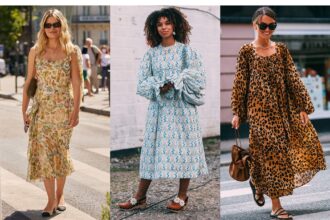Introduction to fast fashion and social media
Fast fashion has become a buzzword in recent years, especially among the Gen Z crowd. As social media platforms like Instagram thrive on visuals, our feeds are flooded with influencers flaunting the latest trends at unbeatable prices. But what happens behind the scenes? The allure of fast fashion can be intoxicating, leading us to constantly refresh our wardrobes while ignoring the hidden costs. It’s time to peel back the layers and explore how this phenomenon shapes not just our closets but also our perception of reality online. What we consider stylish might actually be an illusion crafted by endless cycles of consumption and promotion. Let’s dive into this vibrant yet troubling world where style meets sustainability—or lack thereof.
The impact of Instagram on consumer behavior
Instagram has transformed the way we shop. It’s not just a social media platform; it’s a marketplace that thrives on visuals and aesthetics. A single scroll can expose users to countless fashion trends, often leading to impulsive purchases.
The influence of influencers cannot be overstated. Their curated feeds showcase new styles daily, creating an insatiable appetite for novelty among followers. With each like and comment, brands gain insights into consumer preferences, driving them to produce even more.
Hashtags play a crucial role too. They connect consumers with trending items instantly. A hashtag here or there can spark viral demand overnight.
Moreover, Instagram’s shopping features have blurred the lines between browsing and buying. Users find themselves purchasing clothes directly from posts without ever leaving the app—a seamless experience designed for instant gratification in fashion choices.
How fast fashion creates a constant need for new clothing
Fast fashion thrives on the idea of instant gratification. With new collections dropping weekly, consumers feel an incessant urge to refresh their wardrobes.
Social media amplifies this phenomenon. Influencers showcase trendy outfits that seem essential for every occasion. Scrolling through feeds, many feel pressured to keep up with the latest looks.
This cycle creates a mindset where clothing is disposable rather than cherished. Each season brings a barrage of styles designed to be worn just a few times before being tossed aside.
The need for novelty overshadows quality and durability. Bargains lure shoppers into purchasing more items than they truly need, leading to overflowing closets filled with garments that rarely see the light of day.
As trends shift rapidly, individuals find themselves trapped in an endless loop—always searching for what’s next while neglecting what’s already there.
The dark side of the fast fashion industry
Fast fashion often hides its consequences behind vibrant marketing and flashy designs. Yet, there’s a grim reality lurking beneath the surface.
Labor exploitation is rampant in this industry. Workers are frequently subjected to unsafe conditions, long hours, and meager wages. Many are young women seeking better lives but find themselves trapped in cycles of poverty instead.
Then there’s the environmental toll. The production processes involve toxic chemicals that pollute water sources and harm ecosystems. Landfills overflow with discarded clothing, contributing to the global waste crisis.
Moreover, fast fashion perpetuates a throwaway culture that encourages consumers to see clothing as disposable rather than valuable. This mindset fosters excessive consumption without considering quality or sustainability.
The allure of trendy pieces comes at a heavy price—one that society pays through health risks and environmental degradation while turning a blind eye to these harsh realities.
The environmental consequences of fast fashion
Fast fashion might seem like a quick solution for updating your wardrobe, but it comes with serious environmental consequences. The constant production of cheap clothing leads to massive waste. Many garments end up in landfills after just a few wears.
The textile industry is one of the largest polluters globally, releasing harmful chemicals into water sources. This not only affects aquatic life but also communities relying on these waters for survival.
Furthermore, the demand for resources to produce fast fashion items contributes to deforestation and habitat destruction. It’s a cycle that depletes our planet’s natural beauty.
Every year, millions of tons of fabric are discarded rather than recycled or reused. The impact is staggering when considering how much could be saved through sustainable practices.
As consumers become more aware, the hope lies in shifting towards brands that prioritize ethical manufacturing processes and eco-friendly materials.
Breaking out of the cycle: Alternatives to fast fashion
Breaking free from the fast fashion cycle starts with awareness. It’s essential to understand the impact of our choices on both society and the environment.
One effective alternative is thrifting. Vintage shops and online resale platforms offer unique finds at a fraction of retail prices while promoting sustainability.
Supporting local artisans also makes a difference. Small businesses often prioritize ethical practices, providing high-quality pieces that last longer than trendy items.
If you’re crafty, consider upcycling old clothes into new styles. This not only reduces waste but also allows for personal expression in your wardrobe.
Explore rental services for special occasions. Instead of buying an outfit you may wear just once, renting can save money and closet space while still allowing you to enjoy fashion without guilt.
Embracing these alternatives fosters creativity and individuality while stepping away from consumerism’s grasp.
Promoting sustainable and ethical fashion choices on social media
The fashion landscape is shifting, and social media plays a crucial role in that transformation. As influencers and brands become more aware of the impact of fast fashion, they have started advocating for sustainable choices. This growing movement is not just about aesthetics; it’s about making informed decisions.
By sharing content that highlights sustainable fashion alternatives, consumers can reshape their feeds to reflect values rather than trends. Showcasing thrifted outfits or DIY projects encourages creativity while promoting longevity in our wardrobes. These small shifts can make a significant impact on how we view clothing consumption.
Moreover, platforms like Instagram are perfect for amplifying voices dedicated to ethical practices within the industry. Educating your audience on where to buy ethically made clothes or how to support local artisans opens doors to new possibilities.
Engagement with these topics fosters community awareness around environmental issues linked to fast fashion. Every post has the potential to inspire change—one hashtag at a time.
Let’s embrace this opportunity by curating content that challenges the norms of consumerism and celebrates sustainability. By doing so, we contribute not only toward individual style but also a collective responsibility toward our planet and its future generations.










